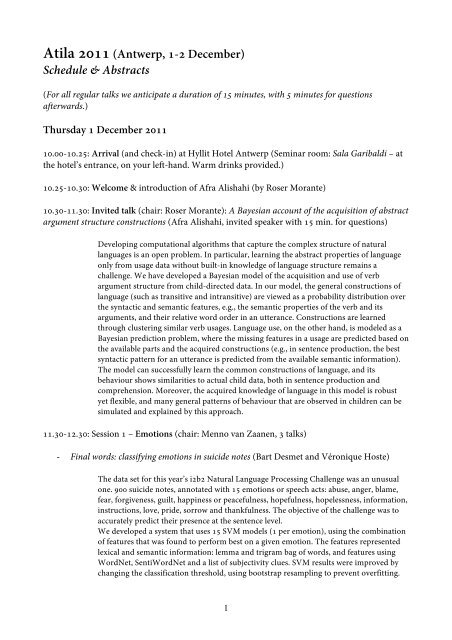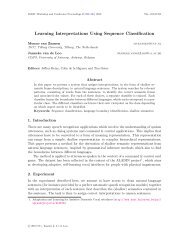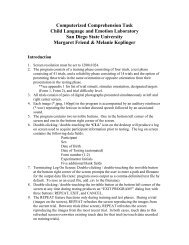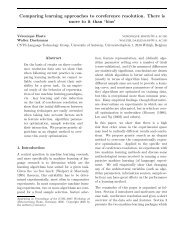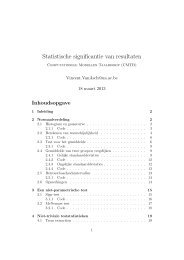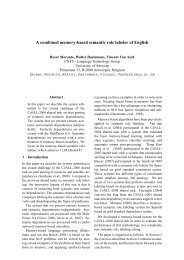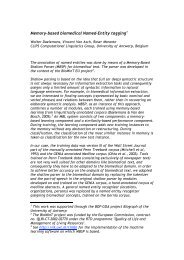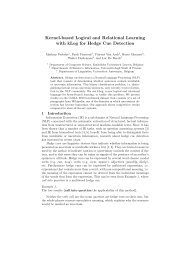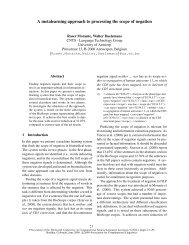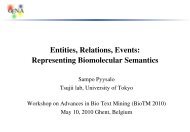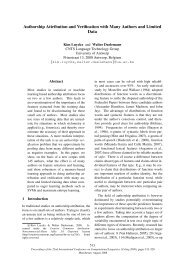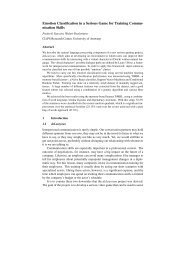Atila 2011 (Antwerp, 1-2 December) Schedule & Abstracts - CLiPS
Atila 2011 (Antwerp, 1-2 December) Schedule & Abstracts - CLiPS
Atila 2011 (Antwerp, 1-2 December) Schedule & Abstracts - CLiPS
You also want an ePaper? Increase the reach of your titles
YUMPU automatically turns print PDFs into web optimized ePapers that Google loves.
<strong>Atila</strong> <strong>2011</strong> (<strong>Antwerp</strong>, 1-2 <strong>December</strong>)<strong>Schedule</strong> & <strong>Abstracts</strong>(For all regular talks we anticipate a duration of 15 minutes, with 5 minutes for questionsafterwards.)Thursday 1 <strong>December</strong> <strong>2011</strong>10.00-10.25: Arrival (and check-in) at Hyllit Hotel <strong>Antwerp</strong> (Seminar room: Sala Garibaldi – atthe hotel’s entrance, on your left-hand. Warm drinks provided.)10.25-10.30: Welcome & introduction of Afra Alishahi (by Roser Morante)10.30-11.30: Invited talk (chair: Roser Morante): A Bayesian account of the acquisition of abstractargument structure constructions (Afra Alishahi, invited speaker with 15 min. for questions)Developing computational algorithms that capture the complex structure of naturallanguages is an open problem. In particular, learning the abstract properties of languageonly from usage data without built-in knowledge of language structure remains achallenge. We have developed a Bayesian model of the acquisition and use of verbargument structure from child-directed data. In our model, the general constructions oflanguage (such as transitive and intransitive) are viewed as a probability distribution overthe syntactic and semantic features, e.g., the semantic properties of the verb and itsarguments, and their relative word order in an utterance. Constructions are learnedthrough clustering similar verb usages. Language use, on the other hand, is modeled as aBayesian prediction problem, where the missing features in a usage are predicted based onthe available parts and the acquired constructions (e.g., in sentence production, the bestsyntactic pattern for an utterance is predicted from the available semantic information).The model can successfully learn the common constructions of language, and itsbehaviour shows similarities to actual child data, both in sentence production andcomprehension. Moreover, the acquired knowledge of language in this model is robustyet flexible, and many general patterns of behaviour that are observed in children can besimulated and explained by this approach.11.30-12.30: Session 1 – Emotions (chair: Menno van Zaanen, 3 talks)- Final words: classifying emotions in suicide notes (Bart Desmet and Véronique Hoste)The data set for this year’s i2b2 Natural Language Processing Challenge was an unusualone. 900 suicide notes, annotated with 15 emotions or speech acts: abuse, anger, blame,fear, forgiveness, guilt, happiness or peacefulness, hopefulness, hopelessness, information,instructions, love, pride, sorrow and thankfulness. The objective of the challenge was toaccurately predict their presence at the sentence level.We developed a system that uses 15 SVM models (1 per emotion), using the combinationof features that was found to perform best on a given emotion. The features representedlexical and semantic information: lemma and trigram bag of words, and features usingWordNet, SentiWordNet and a list of subjectivity clues. SVM results were improved bychanging the classification threshold, using bootstrap resampling to prevent overfitting.1
In this talk, we discuss the usability of this approach for emotion classification, andpresent the results.- Fine-grained emotion detection in suicide notes: Multi-label classification with probabilityestimates (Kim Luyckx, Frederik Vaassen, Claudia Peersman and Walter Daelemans)We present a system to automatically identify emotion-carrying sentences in suicide notesand to detect the specific fine-grained emotion conveyed. With this system, we competedin Track 2 of the <strong>2011</strong> Medical NLP Challenge (Pestian et al., <strong>2011</strong>), where the task was todistinguish between fifteen emotion labels, from guilt, sorrow, and hopelessness tohopefulness and happiness. An additional complication was the fact that half of thesentences was left unannotated, often not for lack of emotion, but for lack ofinterannotator agreement.Since the data set could contain multiple emotions per sentence, we adapted the system toenable assigning multiple emotion labels. The thresholding system devised to producemulti-label classification relies on probability estimates returned by an SVM classifier.Emotion labels are assigned only if their probability exceeds a certain threshold and if theprobability of the sentence being emotion-free is low enough. We show the advantages ofa thresholding approach by comparing it to a naïve system that assigns only the mostprobable label to each test sentence, and to a system trained on emotion-carryingsentences only.- Sentiment Analysis with Pattern 2 (Tom De Smedt and Walter Daelemans)The latest release of the Pattern web mining package for Python(http://www.clips.ua.ac.be/pages/pattern) contains a module for sentiment analysis forDutch and English adjectives. We present the new open source subjectivity lexicon forDutch adjectives. The lexicon is a dictionary of 1,100 adjectives that occur frequently inonline product reviews, manually annotated with polarity strength, subjectivity andintensity, for each word sense. We discuss two machine learning methods we used toautomatically expand the lexicon to 5,500 words. We evaluate the lexicon by comparing itto the user-given star rating of online product reviews. For Dutch book reviews, precisionis 0.77 and recall is 0.83.We demonstrate a current research project that applies the lexicon to Dutch politicalnewspaper articles.12.30-14.00: Lunch (in the Hyllit’s breakfast hall)14.00-15.00: Session 2 – Spelling (chair: Walter Daelemans, 3 talks)- Aligning divergent text versions with anagram hashing (Martin Reynaert)In the framework of the CLARIN-NL project VU-DNC we curate a diachronic corpus ofDutch newspaper texts. These have been annotated for subjectivity and quotations. The 1MW of 1950-1951 diachronic newsaper articles have been digitized by means of OpticalCharacter Recognition. The texts have been semi-manually corrected. As a subpart of ourcuration these ground truth texts are aligned with the noisy OCR-output to create goldstandards for OCR post-correction research.We describe a new token aligner designed to facilitate building OCR gold standards.Alignment is obtained by means of anagram hashing, which allows for numericalcomparison of the word strings in the ground truth versus the noisy OCR version. This2
obust solution bypasses the pattern matching problems which one would encounter witha symbolical alignment procedure. The intermediate column-based format used duringalignment allows for easy integration of the OCR information in the final FoLiA xmlformat.- The Chatty Corpus: a Gold Standard for Dutch Chat Normalization (Claudia Peersman,Mike Kestemont et al.)Recent decades have brought a rapid succession of new communication technologies,including text messages or the numerous forms of Internet communication (e.g. e-mail,blogs, social media). An obvious effect of these recent developments has been the wildproliferation of language variation in written communication, especially affecting surfacephenomena such as spelling. Speakers generally consider their standard languageinadequate for these new settings and adopt a ‘glocal’ language variety, displaying bothcharacteristics from a global ‘Internet language’ as well as their local dialect. Most NLPsystems, however, were not designed to cope with the intense surface variation in Internetspeech and consequently fall short in the early stage of the analysis. We discuss ourannotation guidelines to create a gold standard for Dutch chat normalization and proposea first approach to automatically normalize (Flemish) Dutch chat language.- Deceptive Language Analysis in Italian Criminal Proceedings (Tommaso Fornaciari)Methods for identifying deceptive statements in language could be of great practical usein court and in other legal situations. We focused on criminal proceedings for cases ofcalumny and false testimony in which the Court record contains:1) verbatim transcriptions of testimonies collected during the hearings;2) a judgment which describes the events and clearly identifies the untruthfulstatements for which the defendant have been found guilty.Thanks to this information, we were able to annotate the utterances in the testimonies asfalse, true, or uncertain with a high degree of confidence. This corpus was used to trainmodels able to distinguish true from false utterances using a variety of supervisedmachine learning algorithms, with encouraging results.15.00-15.30: Coffee break15.30-17.00: Panel discussion between Antal van den Bosch, Véronique Hoste and WalterDaelemans (chair and moderator: Kim Luyckx)18.00-19.30: Social activity19.30u-21.00u: Evening dinnerFriday 2 <strong>December</strong> <strong>2011</strong>10.00-11.00: Session 3 – Classification (chair: Véronique Hoste, 3 talks)- Attempting to improve text classification performance using Error-Correcting Output Codes(Frederik Vaassen and Walter Daelemans)3
In the past, Error-Correcting Error Codes (ECOCs) have been used successfully toimprove performance in text classification tasks (Dietterich and Bakiri, 1995). Weinvestigate whether ECOCs remain effective for difficult classification tasks with limiteddatasets. We compare the performance of different codeword matrices, including acodeword matrix that takes the natural subdivisions of the classification framework intoaccount. We compare these ECOC approaches to the more common one vs. all approachand a multiclass classifier. We observe that using ECOCs doesn’t guarantee animprovement in classification performance, and that any gain to be had from using anECOC setup will depend on the difficulty of the underlying classification task.- Handling skewed data: Class division (Menno van Zaanen)Many of the datasets we use as training and testing data in machine learning classificationtasks is skewed. In this case, there is (typically only) one class that occurs much morefrequently than the other classes. The existence of this large class has several effects on thetask, which can be seen in the evaluation.Having skewed data leads to a majority class baseline that is, perhaps unreasonably, high,but more importantly it may also have a negative effect on the results of the classificationsystem. The areas in the instance space that contain instances of the non-majority classesare simply overwhelmed by the areas of the majority class.A typical solution to the effects of skewed data is to perform downsampling. In this case,instances of the majority class as removed from the dataset randomly. This reduces theinfluence of the majority class, but at the same time has the negative effect that potentiallyinteresting instances are simply removed from the dataset.Another alternative, which we propose here, is to divide the majority class into multipleclasses. The system keeps track of the new classes as being part of the original majorityclass, which means that no information is lost. However, the effect of the skewedness ofthe dataset is reduced. The major advantage of this approach is that no data instanceshave to be thrown away.- Applying domain similarity to unsupervised training data construction (Vincent van Ashand Walter Daelemans)11.00-11.30: Coffee breakWhen resources are scarce, additional training data can be obtained by labeling rawcorpora and adding the newly labeled data to the training data. This unsupervised methodcan also be applied when cross-domain experiments are carried out. As has been shown inprevious work, it is possible to measure the degree of similarity of corpora. Test data thatis more similar to the training data will lead to better performance. The underlyinghypothesis of the ongoing research here presented is that data that is more similar to thetest data is more suited to be added to the training data. Preliminary results indicate thatthis hypothesis is valid although labeling accuracy has an influential role.11.30-12.30: Session 4 – Networks (chair: Kim Luyckx, 3 talks)- The Socialist Network (Matje van de Camp)We develop and test machine learning-based tools for the classification of personalrelationships in biographical texts, and the induction of social networks from theseclassifications. A case study is presented based on several hundreds of biographies of4
notable persons in the Dutch social movement. Our classifiers mark relations betweentwo persons (one being the topic of a biography, the other being mentioned in thisbiography) as positive, neutral, or unknown, and do so at an above-baseline level. Atraining set centering on a historically important person is contrasted against a multipersontraining set; the latter is found to produce the most robust generalizationperformance. Frequency-ranked predictions of positive and negative relationshipspredicted by the best-performing classifier, presented in the form of person-centeredsocial networks, are scored by a domain expert; the mean average precision resultsindicate that our system is better in classifying and ranking positive relations (around 70%MAP) than negative relations (around 40% MAP).- Discovering missing Wikipedia inter-language links by means of cross-lingual WSD (ElsLefever and Véronique Hoste)We present a cross-lingual link discovery tool that discovers missing Wikipedia interlanguagelinks to corresponding pages in other languages.Although the framework of our approach is language-independent, we built a prototypefor our application using Dutch as an input language and Spanish, Italian, English, Frenchand German as target languages.The input for our system is a set of Dutch pages for a given ambiguous noun, and theoutput of the system is a set of links to the corresponding pages in our five targetlanguages.Our link discovery application contains two submodules. In a first step all pages areretrieved that contain a translation (in our five target languages) of the ambiguous wordin the page title (Greedy crawler module), whereas in a second step all correspondingpages are linked in the focus language (being Dutch in our case) and the five targetlanguages (Cross-lingual web page linker module).We consider this second step as a disambiguation task and apply a cross-lingual WordSense Disambiguation framework to determine whether two pages refer to the samecontent or not.- Coreference resolution across different genres and the special case of bridge relations(Orphée De Clercq, Véronique Hoste and Iris Hendrickx)During the SoNaR project a 1 million word core corpus has been enriched with foursemantic layers: named entities, coreference relations, semantic roles and spatio-temporalrelations.This talk will focus on the efforts put into annotating the coreference layer with fourrelations: identity, predicative, bridge and bound. We show how SoNaR’s rich diversityenabled us to experiment with an existing mention-pair resolver (Hoste, 2005; Hendrickxet al., 2008) across various text genres. Moreover, because this is the first large-scaleannotation project in which bridge relations are annotated we were also able to seewhether it is possible to tune this same resolver so as to handle these special relations.As for as the different genres are concerned, we see that training on more diverse andgenre-specific information is important but that excluding poor cross-genre material doesnot necessarily result in better performance. Besides, the different evaluation metrics inuse for coreference research today tend to contradict each other which often hampersinterpretation.A closer analysis of the bridge relations revealed that for humans alone, this type ofrelation is very complex and difficult to annotate. We see that adding semantic WordNetinformation does improve performance on resolving bridge relations but these5
improvements are modest and more unambiguous annotation is necessary to betterunderstand this problem.12.30-14.00: Lunch (in the Hyllit’s Gran Duca roof top restaurant)14.00-15.00: Session 5 – Grammar (chair: Lieve Macken, 3 talks)- Grammar induction for assistive domestic vocal interfaces (Janneke van de Loo, Guy DePauw and Walter Daelemans)People with physical impairments who have trouble operating devices manually, couldgreatly benefit from vocal interfaces to control devices at home (such as the TV, radio,lights, etc.). Nevertheless, the use of assistive domestic vocal interfaces by this group ofpeople is still far from common, due to technical and practical constraints. One of themain problems is the lack of robustness of the speech recognition system toenvironmental noise and to idiosyncratic pronunciations related to speech pathologyand/or regional variation. Another important issue is the amount of learning andadaptation required from the user, since a restrictive vocabulary and grammar are usuallypreprogrammed in the system.The ALADIN project aims to address these problems by developing a robust, self-learningdomestic vocal interface that adapts to the user instead of the other way around. Thevocabulary and the grammar of the system are to be learnt on the basis of a limited set ofuser commands and associated controls (actions). The module for unsupervised grammarinduction is designed by <strong>CLiPS</strong>. One of the targeted applications is a voice controlledcomputer game: patience. We have compiled a small corpus of patience commands andassociated moves in a number of Wizard-of-Oz experiments. This audio corpus, manuallytranscribed and linguistically annotated, is used to select an appropriate grammarformalism and semantic representation for the expected range of possible commands, andas input data for some initial grammar induction experiments.- Evaluation of Sentence Simplification (Sander Wubben)In this presentation I will address the task of Sentence Simplification and the evaluationthereof. Sentence Simplification is a popular topic and recent years have seen thedevelopment of various systems. A common approach is to align sentences fromWikipedia and Simple Wikipedia and to train some sort of simplification algorithm onthe sentence pairs. To determine the success such an approach, a measure of evaluation isneeded. Different measures are generally used, such as BLEU and various readabilityscores. In this talk I will give an overview of some of these systems, and I will discuss whysometimes the evaluation used is not very convincing. In addition to that, I will show theresults of a Sentence Evalution experiment we ran ourselves.- Degrees of entrenchment of multi-word units: variation between units and across speakers(Véronique Verhagen)Cognitive linguists argue that high-frequent word strings (e.g. a cup of tea, play hide andseek) are entrenched as one unit. Corpus frequencies are generally regarded as indicativeof degree of entrenchment. However, it first needs to be determined to what extent thereis individual variation, and which factors influence a word string’s salience. If usagefrequency determines degree of entrenchment, you would expect differences betweenlanguage users, as they differ in their linguistic experiences. It is not known, though, how6
15.00-15.30: Coffee breaklarge these differences are. Furthermore, while usage frequency is of great significance, itis improbable that it is the only factor determining degree of entrenchment. If a wordstring is salient in a different manner, it need not occur very often in order to becomeentrenched.Most research into entrenchment makes use of online experiments in combination withcorpus analyses. In my master’s thesis, I examined the usefulness of two offline methods. Iconducted a Magnitude Estimation task in which 70 Dutch native speakers judged thedegree to which the words in a given word combination belong together. Analysesrevealed interesting discrepancies between judgements and corpus frequencies.Furthermore, participants differed substantially in perceived degree of bondedness of thesame multi-word combination.Subsequent focus group discussions revealed that part of this variation is related tovariation in usage. The discussions indicate that judgements are based on an intricateinterplay of features, involving absolute and relative frequency, as well as other aspectsinfluencing an item’s prototypicality and familiarity of form and meaning.I will outline my PhD plans to compare different forms of language processing((re)production, reception and evaluation), and different research methods (offline andonline tasks and corpus research) more extensively.15.30-16.10: Session 6 – Software (chair: Antal van den Bosch, 2 talks)- PyNLPl: Python Natural Language Processing Library (Maarten Van Gompel)The Python Natural Language Processing Library (PyNLPl for short, pronounce as:pineapple) is a collection of reusable Python modules for varous Natural LanguageProcessing tasks. The modules act as building blocks to facilitate the development of NLPtools. There are a number of generic modules, for instance for basic text processing,statistics, and search problems. There are also more specific modules for dealing with avariety of formats commonly found within the context of Dutch ComputationalLinguistics, and for interfacing with software such as Frog and Timbl.- Federated Search (Herman Stehouwer)Within scientific institutes there exist many language resources. These resources are oftenquite specialized and relatively unknown. The current infrastructural initiatives try totackle this issue by collecting metadata about the resources and establishing centers withstable repositories to ensure the availability of the resources. However, due to theheterogeneity of the data collections and the available systems, it is currently impossibleto directly search over these resources in an integrated manner. It would be beneficial ifthe researcher could, by means of a simple query, determine which resources and whichcenters contain information beneficial to his or her research, or even work on a set ofdistributed resources as a virtual corpus. We propose an architecture for a distributedsearch environment. We describe a number of existing archives and corpora participatingin the project. We also detail our experiences with adapting the search systems for thearchitecture. The described infrastructure shall provide a location for researchers toperform searches in many different language resources.16.10-16.30: Farewell and announcements7


